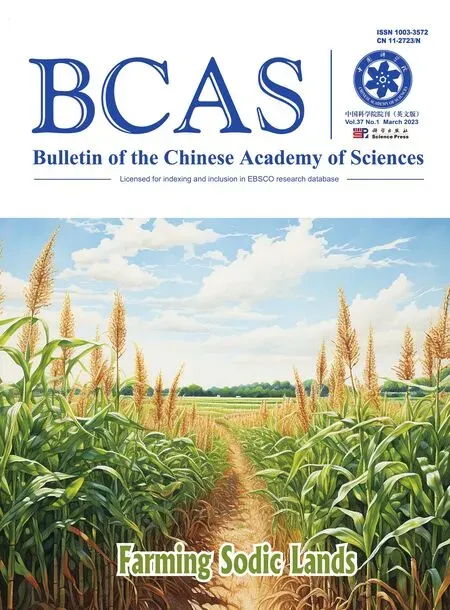Engineering Crops to Thrive on Sodic Lands
By YAN Fusheng (Staff Reporter)
As the world struggles with the threats of climate change and freshwater shortages, a timely breakthrough by scientists from the CAS Institute of Genetics and Developmental Biology (IGDB) and Huazhong Agricultural University provides a ray of optimism.The scientists have identified a genetic locus in sorghum, a droughttolerant cereal grain, that can be modified to enhance alkaline tolerance in various monocot crops.This pioneering work, which could transform millions of hectares of sodic lands into arable farmland, represents a significant stride towards ensuring global food security amidst environmental challenges.
In the face of escalating climate change and the everincreasing scarcity of freshwater, more than half of the world’s arable land is projected to succumb to salt by 2050, warns the Food and Agriculture Organization of the United Nations.However, a groundbreaking discovery offers a beacon of hope – scientists have discovered a promising way to engineer crops that can thrive in such sodic soil, a type of soil dominated by sodium bicarbonate and sodium carbonate.
In a recently published study inScience, a collaborative team, spearheaded by Dr.YU Feifei and Dr.XIE Qi from the Institute of Genetics and Developmental Biology (IGDB) under the Chinese Academy of Sciences,in conjunction with Dr.OUYANG Yidan from Huazhong Agricultural University, have pinpointed a genetic locus in sorghum that plays a crucial role in its sensitivity to alkaline, salty soils.The team also showcased that by modifying this particular locus, the ability of alkaline tolerance in a variety of other crops can be significantly enhanced.This pioneering discovery paves the way for agricultural expansion into the millions of hectares of sodic lands previously deemed unsuitable for cultivation.
Sorghum is an ancient cereal grain that belongs to the grass familyPoaceae.The hearty, drought-tolerant plant has been cultivated as a staple food for a few thousand years in many parts of the world, especially in Africa.It’s like the Hulk of the plant world, its strength stemming from a specific genetic locus the researchers have identified, known asAlkaline Tolerance 1(AT1).
But how does this piece of genetic jigsaw fit into the bigger picture? Digging deeper, the researchers found thatAT1interacts with a group of proteins known as aquaporin PIP2s, which play a crucial role in the regulation of reactive oxygen species (ROS)homeostasis.More specifically, AT1 encodes a unique G protein γ subunit that influences the phosphorylation of aquaporins, thereby modulating the distribution of hydrogen peroxide (H2O2).These intricate processes seem to safeguard plants from the oxidative stress induced by alkaline conditions.

Genetic modification of AT1 enhances alkaline stress tolerance.AT1 protein works with Gβ to limit PIP2 aquaporins, channels that can transport hydrogen peroxide to alleviate oxidative stress, reducing their H2O2 release and causing an excess of H2O2 that makes plants more sensitive to alkaline stress.However, crops with dysfunctional AT1 lift this limitation on PIP2s, boosting H2O2 efflux and enhancing survival and yield under alkaline conditions.(Image by ZHANG et al./Science)
In detail, aquaporins act as the cell’s pumping system, regulating water and hydrogen peroxide flow.WhenAT1interferes with them, it slows the efflux of H2O2and gets intracellular H2O2level building up.As a result, it increases the plant’s oxidative stress that can cause damages to cellular proteins, lipids, and DNA.In a simpler term,AT1works as a negative regulator on aquaporins.
Field tests in a number of monocot crops (sorghum,rice, maize, and millet) solidified the lab’s findings.Crops with the nonfunctionalAT1mutation, both naturally occurring and engineered, showed significant improvement when grown on sodic lands.The team expects that these findings will contribute to maximizing the usage of global sodic lands to ensure future food security.
Expanding this discovery to dicotyledonous crops like tomatoes, potatoes, and fruit trees may appear straightforward.However, researchers urge caution as the homologs ofAT1locus in the dicots have been reported to play opposite roles.
 Bulletin of the Chinese Academy of Sciences2023年1期
Bulletin of the Chinese Academy of Sciences2023年1期
- Bulletin of the Chinese Academy of Sciences的其它文章
- Exercise: The Fountain of Youth at a Cellular Level
- How SARS-CoV-2 Hijacks Our Immune Cells
- Stretchy Electronic Devices Assembled in a Lego-like Way
- Genetically Engineered Bacteria Offer New Hope in Cancer Treatment
- Gene Editing Restores Hearing in Mice
- Gene Editing Offers New Hope for Treating Huntington’s Disease
